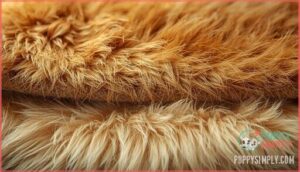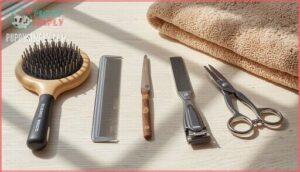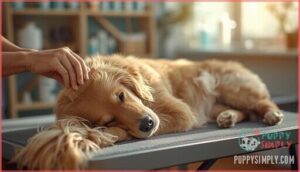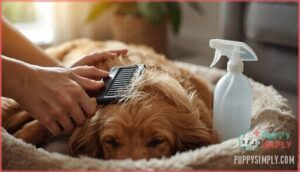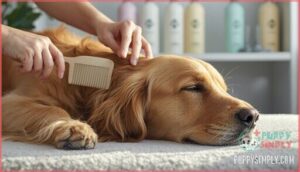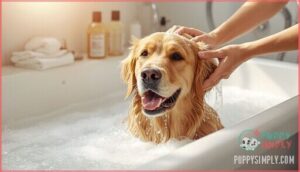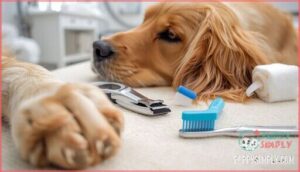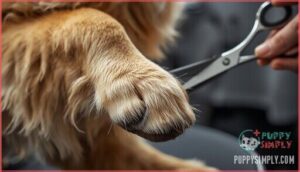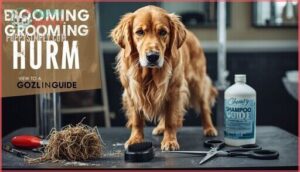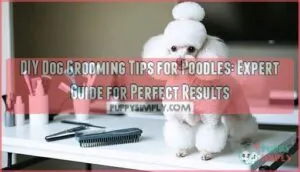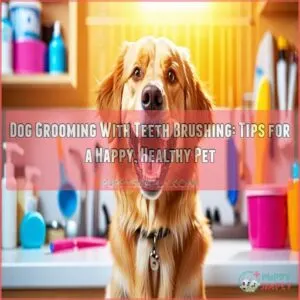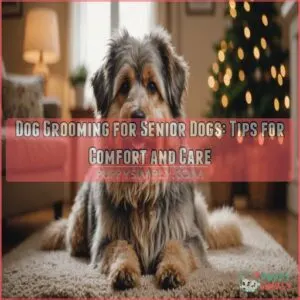This site is supported by our readers. We may earn a commission, at no cost to you, if you purchase through links.
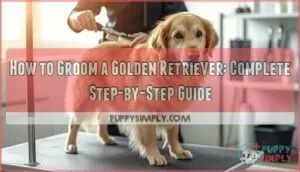 Your Golden Retriever’s coat wasn’t designed to take care of itself. That thick double layer—built to protect them from water and weather—turns into a matted mess without regular attention.
Your Golden Retriever’s coat wasn’t designed to take care of itself. That thick double layer—built to protect them from water and weather—turns into a matted mess without regular attention.
Most owners don’t realize that grooming goes far beyond making your dog look good. It’s about preventing skin infections, catching health problems early, and keeping loose fur from taking over your home.
When you brush correctly, trim strategically, and care for nails, ears, and teeth on schedule, you’re not just maintaining a coat—you’re adding years to your dog’s life.
Table Of Contents
- Key Takeaways
- Why Regular Grooming is Vital for Golden Retrievers
- Understanding The Golden Retriever Double Coat
- How Often Should You Groom Your Golden Retriever?
- Essential Grooming Tools for Golden Retrievers
- Step-by-Step Brushing and Mat Removal
- Bathing Your Golden Retriever The Right Way
- Nail, Ear, and Teeth Care Essentials
- Trimming and Shaping The Golden Retriever Coat
- Common Grooming Mistakes to Avoid
- Frequently Asked Questions (FAQs)
- How long does it take to groom a golden retriever?
- How do you groom a golden retriever?
- When should a Golden Retriever be groomed?
- How often should I brush my golden retriever’s teeth?
- What’s the best way to dry my golden after a bath?
- How can I make grooming easier for my golden who doesn’t like it?
- What should I look out for when trimming the fur between my dog’s paw pads?
- Is it okay to use human shampoo on my golden retriever?
- Can Golden Retrievers be groomed at home only?
- What causes excessive shedding beyond normal seasons?
- Conclusion
Key Takeaways
- Regular grooming prevents serious health problems by catching skin infections, parasites, lumps, and dental issues before they escalate—it’s not about looks, it’s about adding years to your dog’s life.
- Your Golden’s double coat regulates temperature year-round and should never be shaved, since removing it causes sunburn risk, permanent coat damage, and actually makes dogs overheat easier instead of staying cooler.
- Consistent brushing (2-3 times weekly, daily during spring and fall shedding seasons) combined with bathing every 4-6 weeks prevents matting, controls massive fur loss, and maintains the coat’s natural protective oils.
- Neglecting nails, ears, and teeth creates cascading health problems—overgrown nails cause arthritis and gait issues, trapped moisture in floppy ears leads to infections, and skipped dental care results in periodontal disease that spreads to vital organs.
Why Regular Grooming is Vital for Golden Retrievers
Grooming your Golden Retriever isn’t just about keeping them looking good—it’s about keeping them healthy. Regular brushing, bathing, and nail care do more than tame that gorgeous coat. Let’s break down exactly why a solid grooming routine matters for your dog’s wellbeing.
Health Benefits of Grooming
Grooming isn’t just about looks—it’s essential for your Golden’s overall pet health and wellbeing. Regular brushing and care help prevent matting, which traps bacteria and causes painful skin infections.
You’ll catch early detection of lumps, rashes, or parasites like fleas and ticks before they become serious problems. Plus, proper dental hygiene and nail trimming prevent periodontal disease and joint issues that affect dog health long-term.
Consistent grooming also helps with distribution of natural oils for a healthier coat.
Shedding Control and Coat Maintenance
Your Golden’s double coat sheds year-round, but peaks heavily during spring and fall when the undercoat adjusts to temperature changes. Regular brushing with a deshedding tool removes loose fur before it lands on your floors—daily sessions during heavy shedding seasons make the biggest difference.
Diet impact matters too: omega-3s and quality protein support coat health and reduce excessive dog shedding management needs. Genetic factors influence how much your dog sheds, but proper grooming tools and bathing effects can minimize the mess considerably. Remember that shaving their coat isn’t recommended.
Early Detection of Health Issues
Beyond controlling shedding, routine grooming helps you catch dog health concerns before they worsen. Running your hands through your Golden’s coat lets you spot skin abnormalities, lumps, or areas of tenderness that need veterinary attention. Here’s what to check during each session:
- Skin infections and irritation – Look for red patches, scabs, flaky skin, or spots where your dog flinches when touched
- Parasite identification – Part the fur to find fleas, ticks, or flea dirt, especially around ears and between toes
- Ear infections – Watch for ear odors, discharge, redness, or excessive head shaking that signals trouble
- Dental problems – Check for bad breath, bleeding gums, loose teeth, or visible tartar that requires professional cleaning
Since Golden Retrievers are prone to skin issues and ear infections, early lump detection and recognizing dental signs can prevent serious complications down the road.
Understanding The Golden Retriever Double Coat
Before you can groom your Golden Retriever properly, you need to understand what you’re working with. That gorgeous coat isn’t just one layer—it’s actually a specialized double-coat system designed for both protection and temperature control.
Let’s break down how this coat works, why it sheds the way it does, and why certain grooming practices can actually do more harm than good.
Structure and Function of The Double Coat
Think of your Golden Retriever’s coat as a layered shield—each part has a job. The double coat includes a dense, soft undercoat and longer guard hairs (2-4 inches) that form the outer layer.
This coat composition fulfills multiple roles: thermoregulation by trapping air for insulation, water repellency through natural oils, and protective functions against UV rays and debris. The undercoat promotes skin health by facilitating air circulation and moisture control near the skin, preventing infections.
| Coat Layer | Primary Function |
|---|---|
| Outer Guard Hairs | Water repellency, UV protection |
| Dense Undercoat | Insulation, air circulation |
| Natural Oils | Moisture barrier, coat conditioning |
| Combined Structure | Temperature regulation, injury prevention |
Your Golden Retriever’s coat isn’t just beautiful—it’s a well-developed system keeping them comfortable and protected year-round.
Seasonal Shedding Patterns
When photoperiod changes trigger hormonal shifts, your Golden starts what groomers call a "coat blow"—massive undercoat shedding twice yearly. Shedding triggers include increased daylight in spring and fall, causing melatonin drops that activate prolactin release. This hormonal influence drives the double coat to shed heavily from February through July (spring) and August through January (fall), with peak shedding intensity in July, August, and September.
- Expect 3-week peaks where your vacuum becomes your best friend—undercoat loss is dramatic during these windows
- Climate Impact matters: indoor dogs may shed year-round since artificial lighting disrupts natural photoperiod cues
- Daily brushing during coat blow prevents matting and controls the several grams of fur shed daily during peak seasons
Seasonal grooming intensifies during these periods—grooming during shedding season isn’t optional if you want manageable cleanup.
Why Shaving is Not Recommended
While some owners think shaving helps with shedding, it actually backfires—your Golden Retriever’s double coat regulates temperature year-round, and removing it increases sunburn risk by 50-70%.
Shaving damages the coat structure, causing alopecia concerns in 25-30% of dogs with patchy regrowth that may never recover. Thermoregulation impact means your dog overheats easier, not cooler.
Skin irritation and hair loss drive up veterinary costs by 20-35%, making this shortcut expensive long-term.
How Often Should You Groom Your Golden Retriever?
Getting the timing right makes all the difference for keeping your Golden Retriever’s coat healthy and manageable. How often you brush, bathe, and book professional appointments depends on your dog’s lifestyle, the season, and what you’re comfortable handling at home.
Let’s break down what works best for each part of the grooming routine.
Brushing Frequency and Seasonal Adjustments
Your Golden Retriever needs brushing at least once a week, but bumping that up to 2-3 times weekly keeps their coat healthier. During spring and fall shedding seasons, daily brushing becomes your best friend for matting prevention and managing the fur avalanche.
Here’s your seasonal brushing frequency guide:
- Regular maintenance: 2-3 times per week year-round
- Spring shedding season: Daily brushing for 3 weeks
- Fall coat blow: Daily sessions to manage heavy shedding
- Summer/winter: Weekly brushing minimum, more if needed
- Active outdoor dogs: Increase frequency to remove debris
Adjust your brushing techniques based on coat condition—dogs who swim or play outside need more attention to prevent tangles.
Bathing Schedule and Factors Affecting It
Most Golden Retrievers need a bath every 4-6 weeks to balance coat cleanliness with natural oil preservation. Activity levels play a significant role—dogs swimming or playing in mud require bathing every 4 weeks, while less active dogs can stretch to 6-8 weeks.
Skin conditions like hot spots necessitate weekly medicated baths, whereas dry skin benefits from gentle dog shampoo every 6-8 weeks. Your grooming schedule should flex with seasonal adjustments and your dog’s lifestyle.
Professional Vs. At-Home Grooming Frequency
Many owners handle weekly brushing at home but turn to professionals every 8 weeks for full-service grooming, which includes coat trimming, ear cleaning, and sanitary shaves. Professional grooming costs generally range from $65-$85 per session, while DIY challenges like mat removal and feathering benefit from expert hands.
Activity level, coat condition, and breed standards influence your grooming schedule—show dogs need more frequent visits than family pets for maintaining that balanced, natural look.
Essential Grooming Tools for Golden Retrievers
Having the right tools makes grooming your Golden Retriever easier and more effective. You don’t need a professional grooming kit to get started, but certain essentials will help you maintain that beautiful coat at home.
Let’s look at what you’ll actually use and why each tool matters.
Recommended Brushes and Combs
You’ll need a solid lineup of dog brushes to keep your Golden Retriever looking their best. A slicker brush is your go-to—it conquers tangles and removes loose hair from both coat layers.
Pair it with an undercoat rake during heavy shedding seasons to reach that dense underlayer. A greyhound comb with dual spacing completes finishing work, while pin brushes and bristle brushes smooth the topcoat and distribute natural oils for added shine.
Scissors, Thinning Shears, and Nail Clippers
Straight scissors (6.5 to 8 inches) handle general trimming along your dog’s legs and tail, while curved shears shape rounded areas like ears. Thinning shears with 42–46 teeth blend thick spots on the neck and chest—just don’t overdo it, as removing more than 10–15% per session can mess with your dog’s coat insulation.
For nail trimming, scissor-style clippers work best for Golden Retrievers since they give you better leverage. Trim every 3–4 weeks to keep nails below the paw pads. Look for ergonomic shears under 70 grams to protect your wrists during longer sessions.
- Straight scissors: Clean lines on feathering and fuzzy edges
- Thinning shears: Natural blending without choppy layers
- Scissor-style nail clippers: Strong, controlled cuts on thick nails
Best Shampoos and Conditioners
Once you’ve got your tools lined up, dog shampoo and conditioner make or break bath time. Pick formulas with oatmeal, aloe vera, or coconut—these soothe skin and cut down on allergens by up to 86%. Skip anything with formaldehyde preservatives or isopropyl alcohol, since those dry out skin and trigger irritation.
For Golden Retrievers prone to allergies, hypoallergenic or certified organic brands protect that double coat. Always follow shampoo with conditioner to seal the hair cuticle and prevent matting between bathing sessions.
Step-by-Step Brushing and Mat Removal
Brushing your Golden Retriever isn’t just about making them look good—it’s about keeping their coat healthy and comfortable. When you know the right techniques, you can handle everything from routine brushing to stubborn mats without stress.
Here’s how to brush like a pro and tackle tangles the safe way.
Proper Brushing Techniques
Always start brushing from the head and work toward the tail—this method aids proper Coat Alignment and keeps your Golden Retriever comfortable. Back Brushing with a pin brush loosens dead undercoat before smoothing in the natural direction.
Pre-Bath Brushing prevents tangles from tightening when wet. Focus on Feathered Areas like ears, chest, and legs using short, overlapping strokes rather than long sweeps—Stroke Length matters for effective loose fur removal during your Brushing Golden Retriever coats routine.
Removing Tangles and Mats Safely
When you find tangles or matted fur, hold the skin taut at the base to prevent painful pulling—this technique eliminates traction injuries. Work from the mat’s tip toward the root using a wide-tooth comb or slicker brush with stainless steel pins, which removes 90% of surface tangles. Apply a detangling spray to reduce friction by 40%.
If mats exceed one inch thick, use blunt-ended scissors or seek professional intervention—severe matting can trap bacteria and cause hot spots.
Preventing matting and tangles starts with brushing every other day.
Tips for Sensitive Areas
Around the ears, eyes, paws, and tail, gentle brushing prevents discomfort—87% of professional groomers recommend fine-tooth combs for these zones. Use hypoallergenic products near the face to avoid irritation.
Calming techniques like treats reduce anxiety during nail trimming and teeth handling.
If your Golden shows persistent skin irritation or stress, professional groomers use specialized methods that cut grooming-related injuries by 15%.
Bathing Your Golden Retriever The Right Way
Bath time doesn’t have to be a wrestling match if you know what you’re doing. Getting the right products and technique makes all the difference between a clean, happy dog and a soggy disaster.
Here’s what you need to know about shampooing, rinsing, and drying your Golden Retriever properly.
Choosing The Right Shampoo
Your Golden’s skin deserves the right match—not all dog shampoos are created equal. Look for sulfate-free, pH-balanced formulas that won’t strip natural oils from that thick double coat.
If your pup has sensitive skin, hypoallergenic shampoos with colloidal oatmeal or aloe vera work wonders. Natural ingredients like coconut and honey add moisture without harsh chemicals.
For odor elimination between baths, try gentle shampoos with cedarwood or baking soda that keep your dog smelling fresh without irritation.
Bathing Process and Drying Tips
Before you even turn on the water, brush out any loose fur—this makes the whole process easier. Test the water temperature on your inner wrist; it should feel lukewarm, around 98–102°F.
Use a handheld showerhead to soak the coat thoroughly, then work dog shampoo through to the skin. Let conditioner sit for 2–3 minutes, then rinse twice to clear out residue.
Towel dry first, then finish with a pet dryer on low heat, brushing as you go to lift the undercoat.
Avoiding Over-Bathing and Skin Issues
Bathing too often strips your dog’s skin of natural oils and disrupts the skin microbiome, leaving room for bacterial overgrowth and irritation. Stick to a bathing frequency of every 4–6 weeks for most Golden Retrievers—this protects skin health without sacrificing cleanliness. Use a pH-balanced shampoo formulated for dogs to avoid dry skin and dermatitis.
Between baths, brush regularly and check for redness or flaking, especially since breed conditions like atopic dermatitis affect 10–15% of Goldens. Preventative care beats fixing problems later.
Nail, Ear, and Teeth Care Essentials
Grooming isn’t just about keeping your Golden looking good—nails, ears, and teeth play a huge role in their overall health and comfort.
Neglecting these areas can lead to infections, pain, and even long-term health problems. Let’s walk through how to handle each one safely and effectively.
How to Trim Nails Safely
Trimming your dog’s nails isn’t just about looks—it’s essential for proper gait and joint health. You’ll need canine nail clippers (guillotine or plier-style work best) and styptic powder for bleeding control if you nick the quick.
That pink center houses nerves and blood vessels, so aim to trim just the curved tip at a slight angle. For dark nails, watch for a whitish dot when you’re getting close.
Trim every 3–4 weeks using positive reinforcement—treats between each nail help anxious dogs cooperate and make dog nail care stress-free.
Cleaning Ears to Prevent Infections
Those floppy ears that make your Golden Retriever so lovable also trap moisture and debris—a perfect storm for infections. Around 15% of vet visits involve ear problems, and Goldens face nearly double the risk compared to breeds with upright ears.
Check ears weekly for these infection early signs:
- Redness or swelling inside the ear flap or canal opening
- Dark discharge that looks waxy, crusty, or has a yeasty smell
- Head shaking or tilting, especially after swimming or baths
- Scratching persistently at ears or rubbing head on furniture
- Sensitivity when you touch the ear area during grooming
Use a veterinary ear cleaning solution—not alcohol or hydrogen peroxide—and fill the canal before massaging the base. Let your dog shake, then wipe visible debris with gauze. Clean weekly or after water exposure, and always dry thoroughly since breed ear shape limits airflow. Skip cotton swabs; they pack debris deeper and risk injury.
Maintaining Oral Hygiene
Your Golden’s mouth needs as much attention as those ears. About 80% of dogs show dental disease by age two, yet fewer than 4% of owners brush daily—the best practice for dog dental hygiene prevention.
Brushing frequency matters more than you’d think. Daily brushing with a canine toothbrush and enzymatic paste cuts plaque dramatically compared to weekly attempts. Start by touching gums regularly so your dog accepts the routine, then brush three times weekly minimum.
Professional cleanings remove tartar below the gumline that brushing can’t reach, generally needed annually. Dental chews (VOHC-approved varieties work best) help between sessions but don’t replace brushing. Skipping dog oral care invites gum disease, tooth loss, and infections that spread to important organs—a painful, expensive outcome you can prevent with consistent dog teeth cleaning.
| Oral Hygiene Task | Recommended Frequency |
|---|---|
| Brushing teeth | 3–7 times weekly |
| Professional cleanings | Annually or as needed |
| Dental chews | Daily |
| Gum checks | Weekly during grooming |
| Water additives | Daily in drinking water |
Trimming and Shaping The Golden Retriever Coat
Trimming isn’t about giving your Golden a haircut—it’s about tidying up the fuzzy bits and keeping that natural, flowing look intact. You’ll focus on specific spots like the feet, ears, and tail to prevent tangles and maintain balance.
Here’s where to trim, what tools work best, and how to shape without overdoing it.
Where and How to Trim
Where should you focus your efforts when trimming a Golden Retriever’s coat? Start with the ears, paws, and tail—these areas need attention every 6–8 weeks to prevent matting and keep your dog comfortable. Sanitary trimming around the genital and rear regions is essential for hygiene, ideally done every 4–6 weeks.
Here’s your trimming roadmap:
- Paw Pad Trim: Cut hair flush to the pads monthly to improve traction and prevent debris buildup
- Ear thinning: Never shave—just thin the hair to maintain airflow and reduce infection risk
- Tail feathering: Shape into an even V to keep that signature Golden look while staying clean
For trimming dogs’ feet, use rounded scissors and always cut in the direction of growth. Safety practices matter—disinfected tools reduce infection risk by up to 70%. Keep sessions under 60 minutes to minimize stress.
Tools for Feathering and Shaping
You’ve got your plan for where to trim—now let’s talk about the right tools to perfect those feathered areas. Professional groomers rely on a focused toolkit to shape and blend without leaving harsh lines or thinning too much.
| Tool | Primary Use | Pro Tip |
|---|---|---|
| Slicker Brush | Daily detangling of feathering on legs and tail | Reduces loose hair by 80% during heavy shedding |
| Metal Combs | Precision work on hidden tangles behind ears | Use wide teeth first, then narrow for finishing |
| Thinning Shears | Blending transitions without visible scissor marks | Choose 20–45 teeth models to reduce bulk safely |
| Undercoat Rakes | Removing dead undercoat from chest and legs | Weekly use cuts shedding by 75% in feathered zones |
| Grooming Scissors | Shaping hocks, ears, and tail edges | Blunt-tip scissors prevent accidental nicks in sensitive spots |
Start with your slicker brush and metal comb to prep the feathering—over 75% of groomers swear by this combo. Then reach for thinning shears to trim feathering smoothly, cutting bulk without harsh edges. Straight scissors work best for clean leg lines, while curved ones help round out ears and tails.
Quality tools ($20–$120 range) stay sharp longer and make the job easier.
Achieving a Natural, Balanced Look
With your tools ready, trimming means following your Golden’s natural lines instead of fighting them. Here’s how you keep balance right:
- Preserve feathering length — Maintain 2–3 inches behind legs and tail to protect the double coat’s water resistance, which drops 20–30% when cut too short.
- Taper gradually — Blend thicker areas like the neck and tail base down to lighter ends using thinning shears at a 45° angle from hock to shoulder.
- Trim the tail flag-style — Shape from base to tip in a gentle taper, removing no more than one inch overall for proportional symmetry.
Don’t clip around joints or shoulders—you’ll mess with temperature regulation and texture preservation. Light passes with thinning shears reduce bulk by 10–15% without damaging guard hairs that take months to regrow.
Common Grooming Mistakes to Avoid
Even experienced owners can slip into habits that damage their Golden’s coat or miss issues that affect long-term health. Knowing what not to do is just as important as mastering the right techniques.
Let’s walk through the three most common grooming mistakes and how to avoid them.
Over-Trimming or Shaving The Coat
Think of shaving your Golden like stripping away a built-in thermostat—it doesn’t cool them down, it damages their natural protection. Shaving exposes skin to sunburn and disrupts the double coat’s ability to regulate temperature.
Shaving your Golden’s double coat strips away their natural thermostat, exposing skin to sunburn and disrupting temperature regulation instead of cooling them down
The undercoat grows back faster than guard hairs, creating patchy, woolly regrowth that may take years to normalize. Some dogs experience permanent hair loss or coat texture changes.
Instead, stick with regular brushing and professional trimming that leaves at least an inch of coat intact.
Neglecting Nails, Ears, or Teeth
When nails, ears, and teeth get pushed to the back burner, small issues snowball into serious health problems. Here’s what you’re risking:
- Nail Overgrowth Risks – Long nails alter gait and posture, increasing arthritis risk and causing painful fractures that expose the quick.
- Ear Infection Dangers – Moisture-trapped ears breed bacteria and yeast; up to 20% of dogs get ear infections annually.
- Dental Disease Impact – Over 80% of dogs develop periodontal disease by age three, leading to heart and kidney complications.
- Mobility Behavior Effects – Paw pain reduces exercise, while ear discomfort causes head-shaking injuries.
- Preventative Grooming – Trim nails every 3–4 weeks, clean ears after baths, and brush teeth three times weekly.
Regular nail care, ear cleaning, and dental care prevent these cascading problems entirely.
Ignoring Your Dog’s Comfort and Cues
When your dog backs away or tucks its tail during grooming, that’s not stubbornness—it’s stress signal recognition you can’t afford to miss. Ignoring dog comfort and dog behavior cues leads to serious grooming accidents; 72% of incidents happen when handlers overlook early warning signs like lip licking or trembling.
This communication breakdown triggers physiological responses—elevated cortisol and anxiety that persist hours after grooming ends. Behavioral consequences compound over time, turning calm dogs defensive and creating grooming nervous dogs who need extensive positive reinforcement to rebuild trust.
Frequently Asked Questions (FAQs)
How long does it take to groom a golden retriever?
A full grooming session usually takes one to four hours at home, depending on your dog’s coat condition and cooperation level.
Professional grooming appointments usually run two to three hours, covering all essential tasks in your grooming routine.
How do you groom a golden retriever?
Grooming a Golden Retriever involves brushing 3-5 times weekly with a slicker brush, bathing every 4-6 weeks, trimming nails every 3-4 weeks, cleaning ears weekly, and brushing teeth daily to maintain a healthy coat and prevent health issues.
When should a Golden Retriever be groomed?
You’ll need to groom your Golden Retriever based on coat condition, activity levels, and seasonal changes.
Brush 2-3 times weekly, increasing to daily during spring and fall shedding seasons, while maintaining a regular grooming routine every 4-6 weeks.
How often should I brush my golden retriever’s teeth?
Aim for daily brushing to prevent dental problems and tartar buildup. If that’s tough, brushing at least two to three times per week still helps protect your dog’s oral health and reduces breed predispositions to periodontal disease.
What’s the best way to dry my golden after a bath?
Start with a towel: Pat your golden dry with a microfiber towel first, pressing gently from head to tail.
Then use a dog dryer on low or cool settings, focusing on the undercoat and skin folds.
Skip air drying—it risks matting and skin health problems.
How can I make grooming easier for my golden who doesn’t like it?
If your dog dreads grooming time, turn it into bonding time with treats and positive reinforcement. Watch for behavioral cues like lip licking or trembling, and create a calming environment with quiet tools.
For severe dog anxiety, seek professional help.
What should I look out for when trimming the fur between my dog’s paw pads?
When trimming between your dog’s paw pads, watch for sensitive nerve endings in the digital pads and avoid cutting too close.
Trim every four to five weeks to prevent fungal infections, hyperkeratosis risk, and slipping injuries while maintaining proper traction.
Is it okay to use human shampoo on my golden retriever?
No—human shampoo disrupts your dog’s pH balance and strips essential oils, causing skin irritation and increasing infection risk.
Always use a dog-specific shampoo formulated for canine skin care to protect your golden’s coat and prevent toxic ingredient exposure.
Can Golden Retrievers be groomed at home only?
Yes, you can handle most grooming at home with proper tools and techniques. Brushing 3-5 times weekly, monthly baths, and regular nail trims are manageable DIY grooming tasks.
However, professional grooming every 8-10 weeks helps with detailed coat shaping and sanitary trims.
What causes excessive shedding beyond normal seasons?
Excessive shedding beyond normal seasons often signals underlying issues. Endocrine disruptions like hypothyroidism, allergic reactions, parasitic infestations, nutritional deficiencies, or psychological stress can all trigger abnormal hair loss.
These conditions affect your dog’s skin care needs and overall coat health considerably.
Conclusion
Here’s the truth: how to groom a golden retriever isn’t about flawlessness—it’s about consistency. When you brush weekly, bathe monthly, and keep those nails trimmed, you’re doing more than preventing mats.
You’re spotting lumps early, stopping ear infections before they start, and giving your dog the kind of comfort they can’t ask for but absolutely deserve.
Skip the grooming, and you’re not just dealing with fur everywhere—you’re missing warning signs that could save their life.
- https://www.snowypineswhitelabs.com/guides/guide-to-grooming-golden-retrievers/
- https://www.halocollar.com/blog/dog-health/all-about-golden-retriever-shedding-what-to-expect/
- https://www.pawparentacademy.com/blog/the-ultimate-guide-to-golden-retriever-grooming
- https://pawspace.in/benefits-of-grooming-your-golden-retriever/
- https://birminghamanimalhospital.com/dog-grooming-improves-health-and-happiness/

